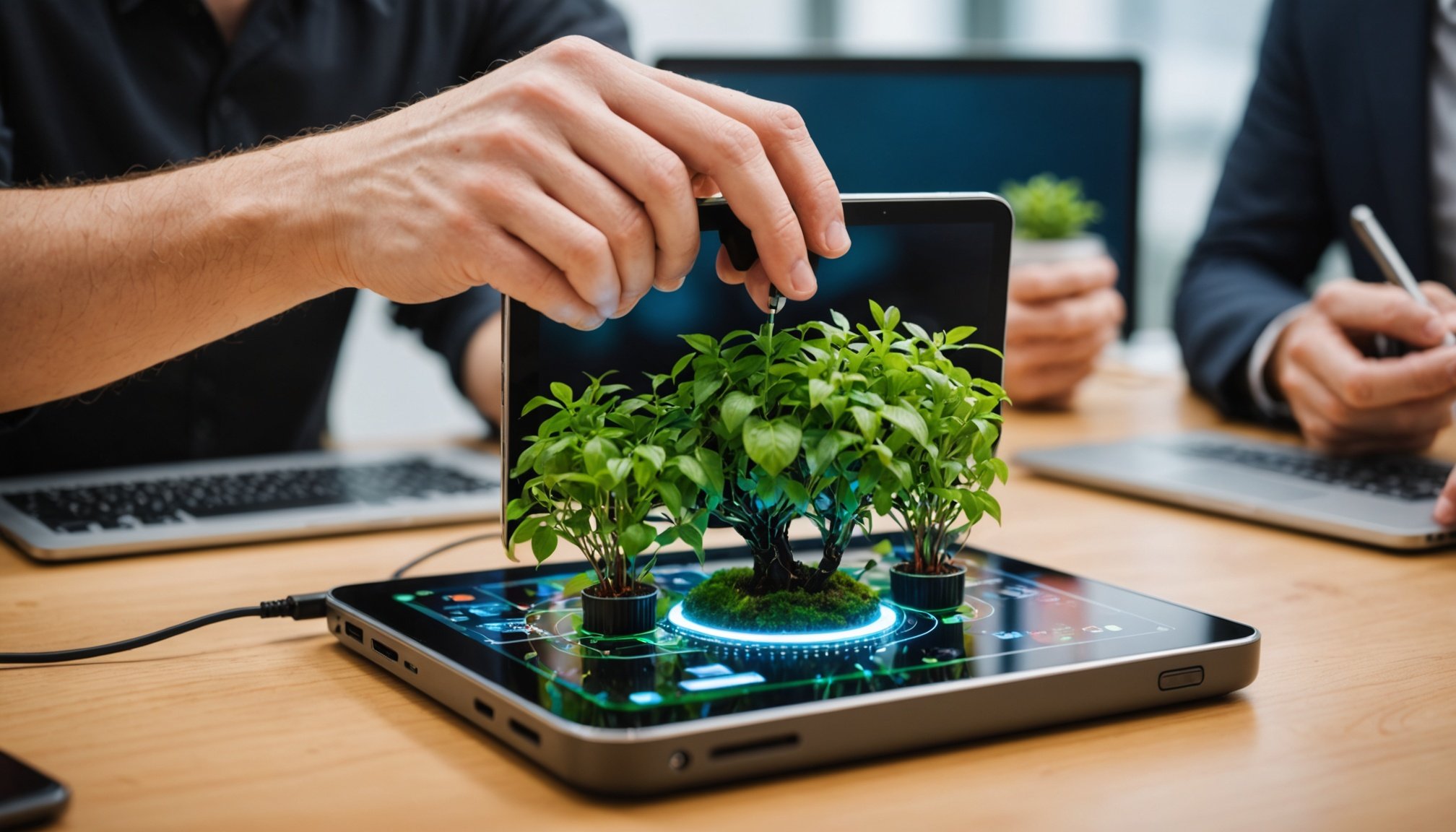Unveiling Cutting-Edge Sustainable Consumer Electronics Trends in the UK
As we navigate the complexities of the modern world, the intersection of technology and sustainability has become a critical focus, particularly in the consumer electronics sector. The UK, a hub for innovation and tech advancement, is at the forefront of this movement. Here, we delve into the cutting-edge sustainable consumer electronics trends that are reshaping the industry.
The Rise of Online Shopping and Sustainable Practices
The UK’s consumer electronics market is experiencing a significant shift, driven largely by the rise of online shopping and a growing emphasis on sustainability. According to Trade.gov, the e-commerce sector in the UK is witnessing remarkable growth, with an annual increase of 12.6% predicted. This surge is partly due to unfavorable weather conditions and the convenience of online shopping, which has become the norm, especially during festive seasons like Christmas[1].
Have you seen this : Find your dream luxury home with real estate agency les gets
Key Statistics:
- Increase in Online Spending: Online expenditures have risen by 4%, while in-store purchases have decreased by 2% year-over-year.
- Second-Hand Market Boom: There has been a 21% increase in global sales on second-hand online markets, with younger and middle-aged generations actively using these channels.
- Sustainable Shopping: The trend towards sustainable and second-hand shopping is gaining traction, allowing consumers to purchase their favorite items at a fraction of the cost while reducing environmental impact.
This shift towards online and sustainable shopping is not just a fleeting trend but a long-term change in consumer behavior. As consumers become more environmentally conscious, companies are adapting to meet these new demands.
Green IT and Digital Sustainability
The digital sector, including consumer electronics, is under increasing pressure to reduce its environmental footprint. The Science Based Targets Initiative (SBTi) highlights that the digital sector must reduce its emissions by 45 to 62% between 2020 and 2030 to limit global warming[2].
Topic to read : Unveiling the impact of ai innovations on predictive policing in the uk
Challenges and Solutions:
- Resource Competition: The transition to ecological sustainability requires a significant increase in metal extraction, largely for electric vehicles. However, the digital sector is also a major user of metals, making sobriety in digital practices crucial to reduce future resource competition.
- Water and Energy Consumption: Issues such as water consumption by data centers and the environmental impact of electronic manufacturing are becoming critical. For instance, Microsoft’s data center in the Netherlands made headlines in 2022 due to its high water consumption.
- Sustainable Practices: Companies are now focusing on developing and implementing more sustainable practices. This includes extending the life of IT equipment, reevaluating equipment allocation, and promoting sustainable sourcing and recycling practices.
The Role of Innovation and R&D
Innovation is the backbone of the consumer electronics industry, and sustainable innovation is no exception. The UK is home to several R&D centers that are driving this change.
Examples of Innovation:
- Artificial Intelligence (AI): AI is being used to optimize energy consumption in consumer electronics. For example, smart home devices can learn and adjust energy usage patterns in real-time to minimize waste.
- Energy-Efficient Products: Companies are developing products with high energy efficiency. This includes devices with advanced power-saving features and those that utilize renewable energy sources.
- Sustainable Packaging: There is a growing focus on sustainable packaging, reducing waste and using eco-friendly materials. This not only reduces the environmental impact but also enhances the brand’s reputation among conscious consumers.
Government Initiatives and Regulatory Frameworks
Government initiatives play a crucial role in driving sustainable practices in the consumer electronics industry. In the UK, there are several regulatory frameworks and incentives that encourage companies to adopt sustainable technologies.
Key Initiatives:
- Net Zero Targets: The UK government has set ambitious net zero targets, and companies are under pressure to align their strategies with these goals.
- Green IT Policies: Policies aimed at reducing the environmental impact of digital technologies are becoming more stringent. This includes regulations on energy consumption, waste management, and sustainable sourcing.
- Incentives for Sustainable Practices: Governments are offering incentives for companies that invest in sustainable technologies and practices. This includes tax breaks, grants, and other financial incentives.
Market Trends and Consumer Behavior
The global market for consumer electronics is undergoing significant changes, driven by evolving consumer behavior and technological advancements.
Consumer Preferences:
- Eco-Friendly Products: Consumers are increasingly looking for eco-friendly products. According to a survey, 80% of French consumers believe the sector should invest in ecological transition, although only 7% are willing to pay the extra cost associated with sustainable products[3].
- Digital Transformation: The digital transformation is changing how consumers interact with electronics. For instance, 49% of consumers consider free shipping a decisive factor, followed by 24% who prioritize fast shipping[3].
- Multichannel Experience: Consumers are expecting a seamless multichannel experience. 63% of distributors offer an omnichannel experience, and 71% of industrials and 81% of distributors anticipate significant growth in e-commerce revenues[3].
Practical Insights and Actionable Advice
For companies looking to adapt to these trends, here are some practical insights and actionable advice:
Embrace Sustainable Practices:
- Invest in R&D: Continuously invest in research and development to create innovative, sustainable products.
- Implement Green IT: Adopt Green IT practices such as extending the life of equipment, promoting sustainable sourcing, and reducing energy consumption.
- Use Eco-Friendly Packaging: Transition to sustainable packaging materials to reduce waste and enhance brand reputation.
Engage with Consumers:
- Educate Consumers: Educate consumers about the benefits of sustainable products and practices.
- Offer Incentives: Provide incentives for consumers who choose sustainable options, such as discounts or loyalty points.
- Collect Feedback: Collect feedback from consumers to understand their preferences and adjust strategies accordingly.
Collaborate with Stakeholders:
- Work with Suppliers: Collaborate with suppliers to ensure they adhere to sustainable practices.
- Engage with Government: Work closely with government agencies to stay updated on regulatory changes and leverage incentives.
- Partner with NGOs: Partner with non-governmental organizations (NGOs) to enhance credibility and impact.
The consumer electronics industry in the UK is at a pivotal moment, with sustainability and innovation driving the future. As consumers become more environmentally conscious, companies must adapt to meet these new demands. By embracing sustainable practices, investing in innovation, and engaging with consumers and stakeholders, companies can not only reduce their environmental impact but also thrive in a rapidly changing market.
Table: Key Statistics and Trends
| Statistic | Description | Source |
|---|---|---|
| 12.6% Annual Growth | Predicted annual growth in the UK e-commerce sector | Trade.gov[1] |
| 4% Increase in Online Spending | Year-over-year increase in online expenditures | Trade.gov[1] |
| 21% Increase in Second-Hand Sales | Increase in global sales on second-hand online markets | Trade.gov[1] |
| 45-62% Emission Reduction | Required emission reduction for the digital sector by 2030 | SBTi[2] |
| 78% Distributors with High Maturity on Ecological Transition | Percentage of distributors with high maturity on ecological transition | LearnThings[3] |
| 7% Consumers Willing to Pay Extra for Sustainability | Percentage of consumers willing to pay extra for sustainable products | LearnThings[3] |
| 49% Consumers Prioritize Free Shipping | Percentage of consumers who consider free shipping a decisive factor | LearnThings[3] |
Detailed Bullet Point List: Steps to Adopt Sustainable Practices
- Conduct an Environmental Impact Assessment: Evaluate the environmental impact of your current operations and products.
- Identify areas for improvement.
- Set clear, measurable goals for reduction.
- Invest in R&D: Allocate resources to research and development focused on sustainable technologies.
- Develop energy-efficient products.
- Explore the use of renewable energy sources.
- Implement Green IT Practices: Extend the life of IT equipment, promote sustainable sourcing, and reduce energy consumption.
- Encourage the reuse and recycling of electronic devices.
- Optimize data center operations to minimize water and energy consumption.
- Transition to Sustainable Packaging: Replace traditional packaging materials with eco-friendly alternatives.
- Reduce packaging waste.
- Enhance brand reputation through sustainable practices.
- Engage with Consumers and Stakeholders: Educate consumers about the benefits of sustainable products and practices.
- Provide incentives for choosing sustainable options.
- Collaborate with suppliers, government agencies, and NGOs to ensure a comprehensive approach to sustainability.
By following these steps and staying informed about the latest trends and regulations, companies in the UK consumer electronics industry can navigate the path to sustainability effectively, ensuring a brighter, more eco-friendly future.











